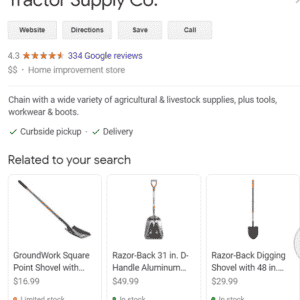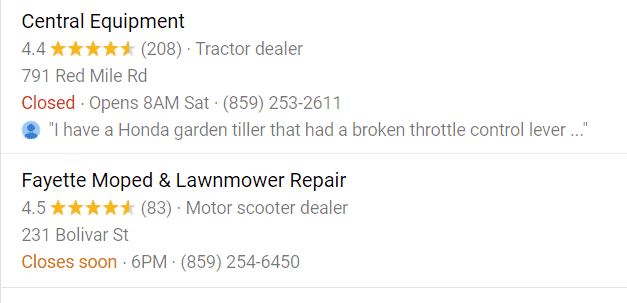Dealerships are presented with immense opportunities to reach and engage with their target audience like never before. The significance of digital marketing for dealers cannot be understated, as it opens doors to a vast pool of potential customers actively seeking lawnmower, tractors and other outdoor power equipment online. However, in the vast sea of digital marketing strategies, one aspect often overlooked yet crucial for success is effective business listing management.
Imagine your dealership being readily accessible to eager customers, precisely when they need you the most. That’s the power of business listings – the virtual storefronts that put your dealership on the digital map. In this blog post, we embark on a journey to unravel the concept of business listings and understand their indispensable role in the ever-evolving digital landscape.
Business listings are the pillars that support local search visibility, online reputation, and customer trust. Whether it’s through platforms like Google Business Profile, Yelp, or Bing Places, these listings not only provide essential information about your dealership but also pave the way for potential customers to find you effortlessly.
Today, we shine a spotlight on the pivotal importance of business listing management for dealerships. We delve into the benefits of having accurate and consistent business information across the digital realm and explore how it can amplify your dealership’s online presence and growth.
Join us as we unravel the secrets to gaining more business listings, optimizing their potential, and efficiently managing them to boost your dealership’s success in the competitive online marketplace. Let’s dive in and unlock the power of business listing management for your dealership’s digital marketing triumph!
Understanding Business Listings
In the vast expanse of the digital landscape, business listings stand tall as indispensable tools for dealerships seeking to establish a strong online presence. Let’s delve into the core aspects of business listings and their far-reaching impact on your dealership’s digital marketing endeavors.
Definition of Business Listings and their Types
Business listings, simply put, are virtual listings of your dealership on online platforms like Google Business Profile, Yelp, Bing Places, and a myriad of other directories. They serve as digital storefronts, providing essential information about your business to potential customers, including your dealership’s name, address, phone number (NAP), operating hours, website URL, and more.
Different types of business listings platforms cater to various audiences and industries. Google Business Profile, as the most prominent player, is essential for local search visibility and often appears on the top right of Google search results pages. Yelp, on the other hand, specializes in customer reviews and recommendations, while Bing Places caters to Microsoft’s search engine users.
Importance of Accurate and Consistent Business Information
Accuracy and consistency are paramount. When potential customers search for your dealership online, they expect reliable and up-to-date information. Inaccurate or conflicting details across various platforms can lead to confusion and erode customer trust.
Maintaining consistent NAP information, along with other crucial details, not only instills confidence in your dealership but also helps search engines understand and verify your business data. This, in turn, contributes to better search rankings and improved online visibility.
Impact of Business Listings on Local Search Visibility and SEO Rankings
The impact of business listings on local search visibility cannot be underestimated. These listings significantly influence local search results, especially in “near me” searches, where search engines prioritize geographically relevant businesses.
Having your dealership listed accurately and consistently across multiple platforms signals to search engines that your business is legitimate and trustworthy, which can lead to higher rankings on local search results pages. Moreover, a well-optimized business listing can also enhance your website’s overall SEO performance.
Benefits of Having an Optimized Business Listing
An optimized business listing can be a game-changer for your dealership, unlocking an array of benefits that directly contribute to your digital marketing success. Some of these benefits include:
Increased Online Visibility: An optimized business listing ensures your dealership appears in local search results, putting you in front of potential customers at precisely the moment they are actively seeking outdoor power equipment solutions.
Enhanced Customer Trust: Consistent and accurate business information fosters trust among your target audience, increasing the likelihood of them choosing your dealership over competitors.
Positive User Experience: Business listings provide customers with all the essential details they need, such as operating hours, contact information, and directions, leading to a seamless user experience.
Better Online Reputation: A well-managed listing encourages customers to leave positive reviews and testimonials, bolstering your dealership’s online reputation and credibility.
Increased Website Traffic: Optimized business listings often include a link to your website, driving more traffic and potential leads to your dealership’s online platform.
Harnessing the potential of an optimized business listing can give your dealership a powerful edge, ensuring you stand out and thrive in the digital landscape.
Why Business Listings Matter for Dealers
Business listings play a pivotal role in shaping the success of dealerships. Let’s delve deeper into the specific reasons why business listings matter so much and how they contribute to the growth and prosperity of your dealership’s digital marketing efforts.
Enhancing Local Visibility and Attracting Nearby Customers
For dealerships, attracting local customers is of utmost importance. When potential customers search for lawnmower and tractor solutions in their vicinity, having a well-optimized business listing ensures your dealership is prominently displayed in local search results.
By leveraging location-based keywords, accurate NAP information, and relevant categories and attributes, your dealership becomes more visible to potential customers in your area. This increased local visibility can significantly boost foot traffic to your physical location and drive qualified leads to your website.
Establishing Trust and Credibility with Potential Clients
Establishing trust and credibility is essential for earning the confidence of potential clients. A well-maintained business listing with consistent and accurate information builds a sense of reliability and authenticity.
When customers find your dealership listed on reputable platforms with positive reviews and comprehensive information, they are more likely to view your business as trustworthy. This trust factor can be the tipping point that turns potential customers into loyal patrons.
Increasing Online and Offline Traffic to the Dealership
The ultimate goal of any dealership’s digital marketing efforts is to drive both online and offline traffic. An optimized business listing serves as a powerful magnet, attracting customers to your dealership through multiple channels.
Online traffic is directed to your website, where potential customers can explore your inventory, learn about your services, and make inquiries. Simultaneously, offline traffic is drawn to your physical location, bringing in potential customers who are ready to make on-the-spot purchases or test drives.
Leveraging Business Listings for Positive Customer Reviews and Testimonials
Positive customer reviews and testimonials are potent tools for enhancing your dealership’s reputation and influence. Business listings serve as a platform for customers to share their experiences, and when these reviews are positive, they become invaluable assets for your dealership.
Encourage satisfied customers to leave feedback on your business listings, as positive reviews not only attract new customers but also signal to search engines that your dealership is worthy of higher rankings. Moreover, proactive responses to customer reviews, especially addressing any concerns or negative feedback, demonstrate your commitment to customer satisfaction.
Business listings are far more than mere digital directories; they are a gateway to local visibility, customer trust, increased traffic, and positive reputation. As dealerships embrace the power of business listing management, they position themselves for digital marketing success, paving the way for sustained growth in the competitive landscape. In the next section, we will explore the key components of effective business listings, equipping you with the knowledge to optimize and excel in this crucial aspect of your dealership’s online presence.
The Key Components of Effective Business Listings
An optimized business listing is the foundation of successful business listing management. To make the most out of these virtual storefronts, dealerships need to focus on specific key components that ensure accuracy, relevance, and user engagement. Let’s explore these essential elements to create an effective business listing that captures the attention of potential customers and enhances your dealership’s online presence.
NAP Consistency (Name, Address, Phone Number)
Consistency is key when it comes to NAP information. Ensure that your dealership’s name, address, and phone number are accurate and consistent across all business listing platforms. Even minor discrepancies can confuse search engines and potential customers, potentially harming your local search rankings and customer trust.
Standardize your dealership’s name, address, and phone number, and verify the information on all major listing platforms. Additionally, if your dealership has multiple locations, create separate listings for each with specific NAP details for each location.
Business Description and Keywords Optimization
Your business description is an opportunity to showcase your dealership’s unique selling propositions and highlight the key services you offer. Craft a compelling and concise business description that accurately represents your brand and resonates with your target audience.
Integrate relevant keywords naturally into your business description to improve search engine visibility. Use location-based keywords to target local customers effectively. However, avoid keyword stuffing, as it can negatively impact the user experience and search rankings.
Images and Multimedia Elements to Showcase Products and Services
Visual content has a powerful impact on potential customers. Leverage high-quality images and multimedia elements to showcase your dealership’s products, services, and facilities. Engaging visuals can create a strong emotional connection with customers and prompt them to take action.
Include images of your inventory, dealership premises, team members, and any special events or promotions. Videos and virtual tours can also provide a more immersive experience for customers, boosting their confidence in your dealership.
Operating Hours, Website URL, and Other Essential Contact Details
Ensure that your business listing provides accurate and up-to-date operating hours. Potential customers are more likely to visit or contact your dealership if they have clear information about when you’re open for business.
Include your dealership’s website URL in the listing to direct traffic to your official website, where customers can find more information about your offerings. Additionally, provide other essential contact details, such as email addresses and social media profiles, to facilitate communication and engagement with your dealership.
Categories and Attributes Selection for Improved Search Relevancy
Selecting appropriate categories and attributes for your business listing enhances its relevance in search results. Choose categories that accurately represent the nature of your dealership’s services and offerings. This ensures that your listing appears in relevant searches and attracts the right audience.
Use attributes to provide additional information about your dealership, such as whether you offer financing options, accept trade-ins, or have multilingual staff. These details help potential customers make informed decisions and choose your dealership over competitors.
Incorporating these key components into your business listing lays a solid foundation for effective business listing management. A well-optimized listing not only enhances your dealership’s online visibility but also establishes trust with potential customers, making them more likely to choose your dealership for their outdoor power equipment needs. In the next section, we will delve into the strategies to gain more business listings and effectively manage them to maximize your digital marketing success.
Strategies to Gain More Business Listings
A strong digital presence is a cornerstone for dealership success in the competitive landscape. To expand your dealership’s online reach and attract potential customers, it is essential to employ effective strategies for gaining more business listings. Let’s explore five proven approaches to amplify your dealership’s visibility and authority across various listing platforms.
Claim and Verify Your Business on Major Listing Platforms
The first step towards gaining more business listings is to claim and verify your dealership on major listing platforms. Start with giants like Google Business Profile, Yelp, and Bing Places, as they have a significant impact on local search visibility.
Claiming your business involves proving that you are the rightful owner of the dealership. The verification process may vary, but it often includes receiving a postcard or phone call with a verification code. Once verified, you gain control over your listing, allowing you to optimize it with accurate information and engaging content.
Identify and Target Niche-Specific Listing Sites
While major listing platforms are essential, niche-specific listing sites can further boost your dealership’s online presence within targeted audiences. Look for directories, forums, and websites that focus specifically on the industry.
Explore local directories, car enthusiasts’ forums, and directories to find platforms that cater to your specific market. Listing your dealership on these platforms can attract customers who are highly interested in outdoor power equipment solutions, leading to more qualified leads and conversions.
Encourage Satisfied Customers to Leave Positive Reviews
Positive reviews are powerful social proof that can sway potential customers in your favor. Encourage satisfied customers to leave feedback on your business listings, particularly on platforms like Google Business Profile and Yelp.
Customer reviews not only influence other customers’ decisions but also impact your dealership’s search rankings. Engage with customers who leave reviews, thank them for their feedback, and address any concerns they may have promptly. Demonstrating responsiveness and gratitude enhances your dealership’s reputation and fosters customer loyalty.
Utilize Local Citations to Boost Your Business’s Online Presence
Local citations are online mentions of your dealership’s NAP (Name, Address, Phone Number) on various platforms, including local directories, social media, and review sites. Consistent and accurate local citations strengthen your dealership’s local SEO and bolster online visibility.
Ensure that your NAP information is consistent across all listings to avoid any discrepancies that could negatively impact your search rankings. You can use citation management tools to streamline the process and monitor your citations across the web effectively.
Collaborate with Local Influencers and Organizations
Leverage the power of local influencers and organizations to expand your dealership’s reach in the community. Identify influential local bloggers, social media personalities, and community organizations that align with your dealership’s brand and values.
Partner with these influencers and organizations to co-promote events, campaigns, or initiatives. Their endorsement can introduce your dealership to new audiences and build trust among potential customers. Consider sponsoring local events or collaborating on charity drives to further strengthen your dealership’s ties with the community.
By implementing these strategies, your dealership can gain a strong foothold on various business listing platforms and connect with potential customers more effectively. Emphasizing the importance of business listing management ensures that your dealership is well-positioned to thrive in the dynamic digital landscape, attracting more customers and accelerating your digital marketing success. In the next section, we will explore the best practices for managing your business listings efficiently to maximize their impact.
Business Listing Management Best Practices
Effective business listing management is vital for dealerships to maintain a strong online presence and make a lasting impression on potential customers. To harness the full potential of business listings, it’s essential to adopt best practices that ensure accuracy, engagement, and positive customer experiences. Let’s explore five essential business listing management practices that will elevate your dealership’s digital marketing efforts.
Monitoring and Responding to Customer Reviews and Feedback
Customer reviews hold significant influence over the perception of your dealership. Regularly monitor your business listings for customer reviews and feedback and respond to them promptly and professionally.
Express gratitude to customers who leave positive reviews, acknowledging their satisfaction and support. For negative reviews, approach the situation with empathy and a willingness to resolve any issues. Publicly addressing concerns and offering solutions demonstrates your dealership’s commitment to customer satisfaction and builds trust with potential customers.
Regularly Updating Business Information to Maintain Accuracy
Keeping your business information up to date is vital to avoid any confusion or frustration among potential customers. Regularly review your business listings and ensure that all details, including NAP information, operating hours, and contact details, are accurate and consistent.
Any changes, such as holiday hours, special promotions, or new services, should be promptly reflected in your listings. Accuracy in business information enhances customer experience and reflects positively on your dealership’s professionalism.
Utilizing Analytics to Track Listing Performance and User Interactions
Leverage the power of analytics to gain valuable insights into your business listings’ performance. Many listing platforms offer analytics tools that provide data on search impressions, clicks, and user interactions.
Analyze these metrics to understand which listings are performing well and attracting the most engagement. Use this information to optimize your business listings further, identify areas for improvement, and tailor your digital marketing strategies accordingly.
Implementing Schema Markup to Enhance Search Engine Visibility
Schema markup is a structured data format that provides search engines with specific information about your dealership, such as the type of business, location, and operating hours. Implementing schema markup on your website can enhance search engine visibility and potentially lead to featured snippets or other rich search results.
Schema markup helps search engines better understand your dealership’s content, which can result in more accurate and relevant search results for potential customers. Consult with your web developer or utilize tools to implement schema markup effectively.
Adopting a Proactive Approach to Address Negative Reviews and Concerns
Negative reviews are inevitable, but how you handle them can significantly impact your dealership’s reputation. Rather than avoiding negative feedback, adopt a proactive approach to address and resolve customer concerns.
Respond promptly to negative reviews with a genuine willingness to address the issues raised. Offer solutions, invite further communication offline, and take necessary steps to rectify any problems. Demonstrating a customer-centric approach shows potential customers that you value their opinions and are committed to providing excellent service.
By adhering to these business listing management best practices, your dealership can establish itself as a reliable and customer-oriented entity in the digital landscape. Embrace the power of business listing management to create a lasting impression on potential customers, nurture positive relationships, and drive sustained growth in the competitive outdoor power equipment market.
Tools and Platforms for Efficient Business Listing Management
Efficient business listing management requires the right tools and platforms to streamline the process and ensure consistency and accuracy across various listings. Let’s explore the key tools and software available for managing your dealership’s business listings effectively.
Overview of Popular Listing Management Tools and Software
Google Business Profile (GBP): As one of the most influential listing platforms, GBP offers a user-friendly dashboard to manage your dealership’s information on Google Maps and search results. It allows you to update business details, respond to reviews, and track performance metrics.
Yelp for Business: Yelp provides a platform for dealerships to claim and optimize their business listings, respond to reviews, and engage with customers. It offers analytics and insights to track user interactions.
BrightLocal: BrightLocal is a comprehensive local SEO tool that offers listing management features, including citation tracking, duplicate suppression, and review monitoring. It streamlines the process of managing multiple listings across different platforms.
Moz Local: Moz Local assists in managing your dealership’s business listings across various platforms, ensuring NAP consistency and accurate information. It provides data on listing performance and local search rankings.
Synup: Synup is a listing management tool that allows you to monitor and update your business information on multiple directories, ensuring consistency and improving local search visibility.
Comparison of Features, Pricing, and Ease of Use
When selecting a listing management tool or platform for your dealership, consider the following factors:
Features: Look for tools that offer comprehensive features such as NAP consistency checks, review monitoring, analytics, citation management, and schema markup implementation.
Pricing: Consider the cost of the tool or platform and compare it with the features offered. Some tools may have tiered pricing based on the number of locations or features needed.
Ease of Use: Choose a user-friendly tool with an intuitive interface that makes it easy for you or your team to manage listings efficiently.
Integration: Ensure the tool can integrate with your existing digital marketing and analytics tools for a seamless workflow.
Tips for Selecting the Right Tool for Your Dealership’s Needs
Identify Your Requirements: Assess your dealership’s specific needs and objectives for business listing management. Determine which features are crucial for your digital marketing strategy.
Read Reviews and Case Studies: Research customer reviews and case studies of different tools to understand real-life experiences and successes.
Trial Periods: Take advantage of trial periods offered by some tools to test their functionalities and determine if they meet your dealership’s requirements.
Scalability: Consider whether the tool can accommodate your dealership’s growth and the management of multiple locations if applicable.
Customer Support: Ensure the tool provides reliable customer support, as prompt assistance can be critical in managing any potential issues that may arise.
By leveraging the right tools and platforms for efficient business listing management, your dealership can save time, maintain accuracy, and maximize the impact of your listings. Investing in these tools is an investment in the overall success of your dealership’s digital marketing efforts.
Unleashing the Power of Business Listing Management for Dealerships
Throughout this comprehensive guide, we have explored the dynamic world of business listings and their profound impact on dealerships’ digital marketing success. From understanding the essence of business listings to gaining more of them and efficiently managing their potential, we’ve uncovered the keys to elevating your dealership’s online presence and customer engagement. As we come to the end of our journey, let’s reflect on the significance of business listings and the transformative role of business listing management in the ever-evolving digital landscape.
Business listings are not mere virtual listings; they are the gateways to local visibility, customer trust, and online reputation. Embracing business listings enables your dealership to reach potential customers right when they need you, positioning you at the forefront of local search results. Accurate and consistent business information builds credibility, instilling confidence in potential clients seeking outdoor power equipment solutions. These listings serve as virtual storefronts, inviting customers to explore your dealership’s offerings, experience your brand, and connect with your team.
Business listing management is the catalyst that propels dealerships towards digital marketing triumph. By implementing best practices and utilizing effective tools, you can maintain accurate and engaging listings that resonate with your target audience. Timely responses to customer feedback demonstrate a customer-centric approach, solidifying your reputation as a dealership that cares about its clientele. Tracking listing performance through analytics empowers data-driven decisions, ensuring your marketing strategies continually evolve and adapt to meet customer expectations.
Armed with the knowledge and strategies presented in this guide, you are now equipped to supercharge your dealership’s digital marketing success through business listing management. Embrace the power of claiming and verifying your presence on major platforms, reaching niche-specific audiences, and encouraging satisfied customers to leave positive reviews. Harness the potential of local citations, collaborate with local influencers, and adopt a proactive approach in addressing customer concerns. Moreover, leverage powerful listing management tools to streamline your efforts, ensuring consistency, and accuracy across multiple platforms.
Implementing these strategies and best practices is not only an investment in your dealership’s online visibility but also an invitation for customers to embark on an exceptional outdoor power equipment journey with you.
As the digital landscape continues to evolve, your dealership’s success hinges on adaptability and the ability to connect with customers where they are. Business listings offer the gateway to that connection, bridging the gap between your dealership and potential customers seeking excellence.
So, let us embrace the power of business listing management and unlock the full potential of your dealership’s digital marketing endeavors. By integrating these practices into your strategy, you can position your dealership for growth, customer loyalty, and lasting success in the fiercely competitive market. May your journey be guided by innovation, authenticity, and a relentless commitment to customer satisfaction.
Let’s embark on this transformative journey together, driving your dealership towards new horizons of digital marketing success. Happy business listing management!


















